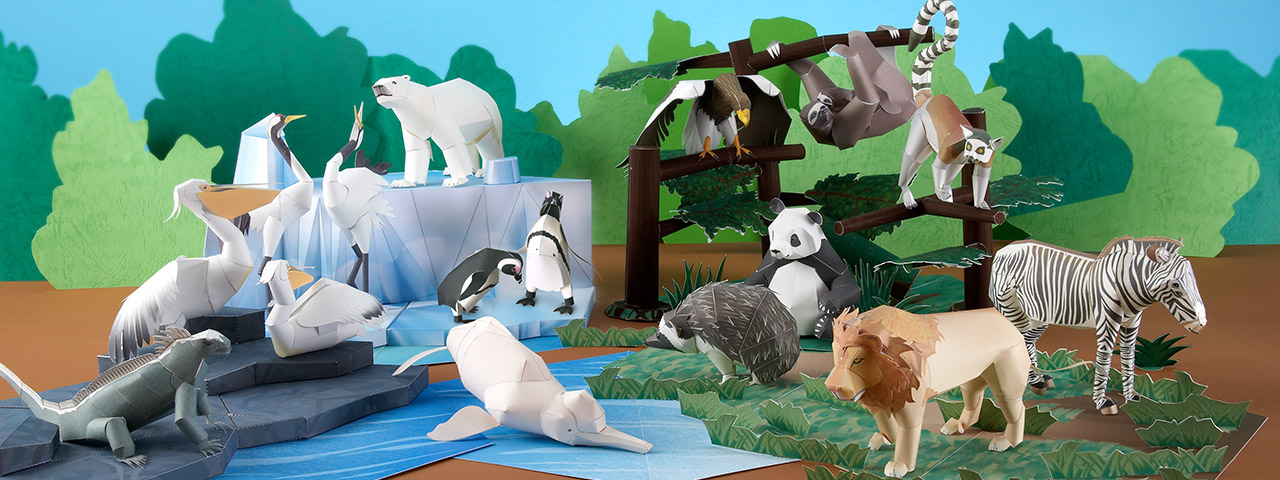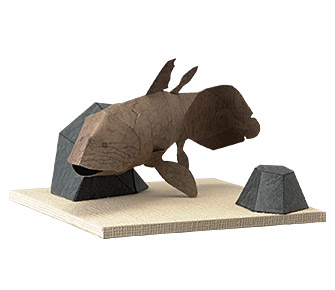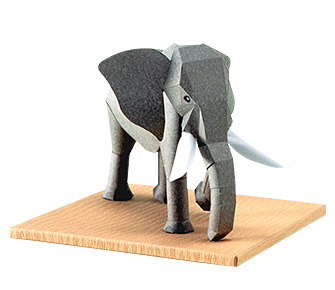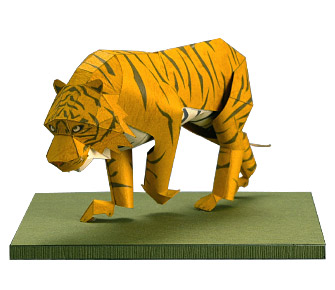Gorilla
Papercraft kit : The gorilla, which has a gentle nature in spite of its scary appearance.

The gorilla is the physically largest species among the primates. The great ape is affectionately considered to be somewhat similar to humans due to its familiar gestures and behavior.
Contrary to its intimidating appearance, the gorilla is actually a gentle creature with a diet consisting mainly of plants. The species is classified as “Critically Endangered [CR]” in the Red List.
Assembly instructions for the Paper Craft Model of the muscular gorilla, as well as a photo image of a completed model, may be downloaded from this website.
Download - Parts sheet & InstructionsThis data was released in July, 2000.
Gorilla - Animal Guide

- Gorilla - Pongidag
- Gorilla gorilla
- Height of male gorillas: 167 - 175cm (approximately 5.5 - 5.7 ft.) / Weight of male gorillas: 150 - 200kg (approximately 330 - 440 lbs.) (Female gorillas usually weigh 3/4 to 1/2 as much as male gorillas.)
- 2016 Edition of the RED LIST categories : Critically Endangered [CR]
The Gorilla is the largest species among primates and the male may weigh approximately 200 kilograms (approximately 440 lbs.) in its maturity. The species is categorized into three geographically distinct subspecies: the mountain gorilla, the eastern lowland gorilla, and the western lowland gorilla. The only subspecies seen in Japanese zoos is the western lowland gorilla, which is, unlike the other two subspecies, characterized by its relatively short, brownish gray hair and downward protruding nose cartilage. Despite to its brawny frame, the gorilla is basically a vegetarian. It lives mainly on fruit, leaves, roots of plants, and tree bark, but the creature occasionally eats ants and other insects as a protein source.
The gorilla is generally a polygamist and its typical band consists of a male leader, called a silverback because its hair from the back to the thigh parts is often silver-colored, and a dozen mature females and their young. The silverback is in charge of the band's migration routes and camping locations, and also carries the responsibility of guarding the band from various intruders.
Habitat
All of the three types of gorillas inhabit the forests of equatorial Africa: the western lowland gorilla in Cameroon and Central Africa, the eastern lowland gorilla in the eastern region of Zaire, and the mountain gorilla in the mountain region that strides the Zaire-Rwanda border and the forests of Uganda slightly to the north. Most of these habitats are not protected by laws and the number of the species is decreasing year by year due to unrelenting poaching for their craniums and fur. In addition, due to deforestation for underground resource mining, the number of gorillas has decreased and the possible extinction of the species has become a concern in some areas. In Japan, zoos in Tokyo are attempting to breed the species on the basis of the worldwide “zoo stock” projects whose purpose is to breed rare animals.

About Red List
The Red List is the material prepared by IUCN (International Union for Conservation of Nature) classifying various threatened wild animals of the world and reporting their present habitat status.
The List evaluates the extinction risk level of each individual species from a biological viewpoint, but it possesses no legal power to enforce regulations concerning threatened species. The Red List is broadly employed as fundamental information in advancing the preservation of threatened wild animals.
Referring to the original Red List, the Environment Agency of Japan has compiled the Japanese edition of the List listing threatened taxa inhabiting Japan.
| Extinct | EX | No known individuals remaining. |
|---|---|---|
| Extinct in the Wild | EW | Known only to survive in captivity, or as a naturalized population outside its historic range. |
| Critically Endangered | CR | Extremely high risk of extinction in the wild. |
| Endangered | EN | High risk of extinction in the wild. |
| Vulnerable | VU | High risk of endangerment in the wild. |
| Near Threatened | NT | Likely to become endangered in the near future. |
| Least Concern | LC | Lowest risk. Does not qualify for a more at-risk category. Widespread and abundant taxa are included in this category. |
| Data Deficient | DD | Not enough data to make an assessment of its risk of extinction. |










